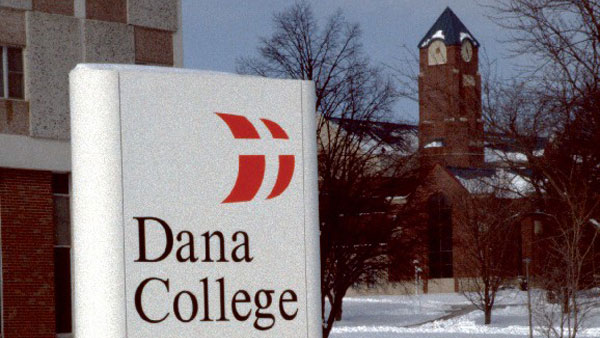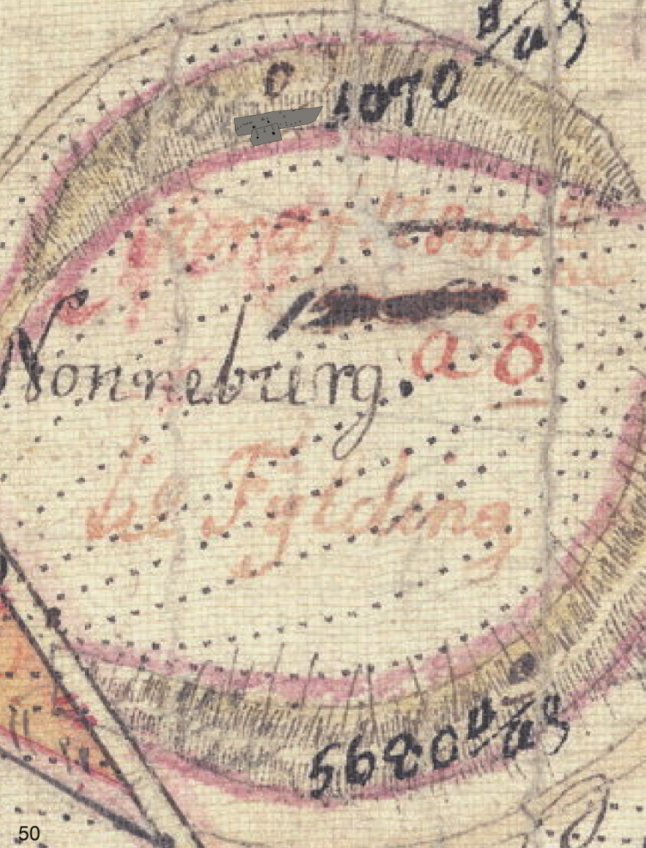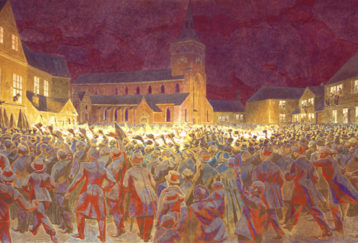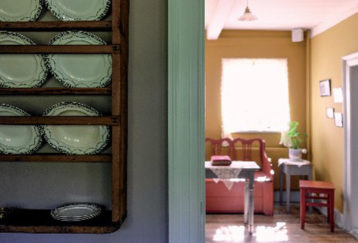
In the Forord to Danske i USA 1850 – 2000, Torben Grøngaard Jeppesen wrote that his interest in emigration began in 1995 during a visit to Dana College in Blair, Nebraska. Here he visited the Danish Immigrant Archive – Dana College and had an opportunity to survey the extensive collections of letters, diaries and journals documenting the Danish immigrant experience. Among the many collections with which he became familiar was the Hansen-Mengers Collection of over 13,000 letters between members and friends of this family who had saved nearly everything spanning a period from the 1880s to the 1980s.

During his visit, I drove him to Elk Horn and Kimballton, Iowa’s Danish villages, to see The Danish Immigrant Museum, which the year before had just opened to the public. I was a charter member of the museum’s Board of Directors, serving from 1983 to 1991, and was eager to share with him the immigrant story told in the museum’s core exhibit. Though the museum was founded in 1983, it had taken ten years to raise enough money to initiate financing the construction. Challenges remained. Repaying the construction loan and meeting staffing needs all through private donations and memberships was daunting.
Now twenty-one years later, much has changed. Dana College no longer exists, the Danish Immigrant Archive – Dana College has become the Danish American Archive and Library and is located on Blair’s main street and not on the Dana College campus whose buildings still stand empty, and The Danish Immigrant Museum adopted a new name, the Museum of Danish America to better serve an evolving constituency. Moreover, the museum has a firm financial foundation with growing endowment to support its active programming.
Since 1995 when we first met, Torben and I have worked together professionally. While completing his research for Danske i USA and living in Madison, Wisconsin, Torben served on the museum’s Board of Directors from 1998 to 2003. I rejoined the board in 2000 and served with him until he completed his second term in 2003. In that year, I assumed the position of the museum’s executive director. Given Torben’s experience leading the Odense City Museums, his help and advice has been invaluable.
In view of the fact that it was at Dana College that we first met and because Dana College played a formative role in the creation of the Museum of Danish America, I offer my observations on its closing. I do so as the experience provides a narrative to Torben’s statistical study and demonstrates the challenges Danish-American institutions face as assimilation occurs.
Dana College was founded in Blair, Nebraska as an educational institution serving a Danish Lutheran immigrant population in 1884. As that population assimilated, the college’s mission became less clear. Additional forces outside the institution’s control contributed both to the assimilation process and exerted pressures that the institution was unable to overcome. Dana College closed in 2010.
On Wednesday, June 27, 2010 an email message notified faculty and staff that Dana College was closing. Offices needed to be vacated by that Friday. Less than two months before classes were to open for the 127th academic year, Dana College students suddenly had to find another school to attend; faculty and staff were left to scramble for employment at a time when most educational institutions had already finalized their hiring for the academic year; Dana alumni across the country and Blair residents were in shock.
On July 8, Wells Fargo Bank filed papers in the District Court of Washington County, Nebraska, requesting that a receiver be appointed: Dana College was in default of bonds financed through the Nebraska Educational Finance Authority. The following Monday, the doors of the thirteen buildings on the 155-acre campus were chained and padlocked. For the last year and half, the once vibrant campus has stood empty.
What led to this dramatic action? Naturally, individuals wanted to find blame, identifying the final college administration for ineffective fundraising, the Higher Learning Commission (the accrediting body for higher education in the United States) for not approving the transfer of Dana’s accreditation to a “for-profit” educational corporation, and even President Obama, the Department of Education, and the U.S. Congress for scrutinizing “for-profit” education. There were, however, no simple answer; no single individual was responsible. Rather, multiple forces contributed to the college’s close.
My purpose here is to describe those forces. My reasons are many. First, I believe that the college was a significant Danish-American institution. Second, the forces that contributed to Dana’s closure are ones that other Danish-American institutions – from the Danish Brotherhood in America to folk high schools to Danish-American homes for the elderly – have faced. Third, the Museum of Danish America continues to confront these forces, as do organizations like the Rebild National Park Society, Den Danske Pioneer, and Bien (the two existing Danish language newspapers in the United States). Understanding the complex interplay of issues that led to the demise of Dana College may help us as we continue to shape a vision for the Museum of Danish America and the other institutions that knit the Danish-American community together.
It should be noted that I am not a dispassionate bystander to Dana’s story. My family, like many other Danish-American families, had a long history with Dana College. My parents who were the children of Danish immigrants, met there; fourteen of my aunts and uncles attended as did twelve of my cousins; I and my four siblings graduated from Dana; I met my wife, Dawn, there; and our younger son was a Dana graduate. Following graduate school, I joined the Dana faculty in 1978 and taught there for over thirty years until the college closed. My connection to Dana was deep – my perspective not necessarily objective.
Founded in 1884 as Trinity Seminary to train young men as pastors to serve the newly formed Danish Evangelical Lutheran Church Association (DELCA), it was located in Blair, Nebraska because the railroad bridge over the Missouri River provided easy access to Danish immigrant communities in western Iowa and eastern Nebraska. Seeing an opportunity to attract prospective buyers, local land developers in Blair gave the church four lots to entice the church and its school to locate in the community. They stipulated, however, that the institution should also offer academic classes, including commercial courses.
In 1896, the DELCA merged with the Danish Evangelical Church in North America to form the United Danish Evangelical Lutheran Church (UDELC). (Later, the word “Danish” was dropped, and it was known as the UELC). This merger also brought about the union of Trinity Seminary and what was then known as Blair College with the Elk Horn Folk High School, the first Danish folk high school, founded in Elk Horn, Iowa in 1878. Out of this union came Dana College, the name first being used in 1902.
The story of Dana College has been well documented in two histories: The Saga of the Tower by William Christensen published in 1959 when the college celebrated its 75th anniversary and A Place Called Dana by Peter Petersen published in 1984 to celebrate the college’s centennial. Each makes clear that the fortunes of Dana College have mirrored the nation’s economy. During times of economic depression and war, enrollment dropped and budgets were tight; when the economy flourished, the college did well. In the post-World War II era and, particularly, in the 1960s, Dana College expanded rapidly to meet the swelling demand arising from the baby boom as well as the merger of the UELC with German and Norwegian Lutheran synods to form the American Lutheran Church (ALC).
I entered Dana College in 1969 when enrollment reached 1063, the largest the college would ever have; I graduated in 1973 in the college’s largest graduating class of 170. After 1969, enrollments declined, falling to a low point of 392 – the total student population at the beginning of 1985. This drop occurred in part as the Vietnam War drew to a close and the military draft ended, but also because of changes in higher education both in the Nebraska and surrounding states.
Further, because Dana was no longer the only college of a nationwide synod, the student body became more regional. Competition for declining student populations increased. From 1985, enrollments began to climb, reaching a peak of 669 students in 2004. When Dana College closed, enrollment had fallen back to just over 550 students. Throughout this period of ebbing and flowing enrollment, Dana administration, faculty and staff – myself included – attempted to understand the forces at work and how to respond in order to strengthen the college.
An issue that was both strength and challenge for Dana College throughout its history was its identity as a Danish-American institution. Dana College had a rich Danish heritage. This was most clearly evidenced in 1976, when Her Majesty Queen Margrethe II, during her tour of the United States honoring the nation’s bicentennial, chose Dana College to deliver her only official speech.
When she visited the campus, the Queen walked under gas lamps dating from 1857 that had been gifted to the college by the City of Copenhagen. She passed beech trees from the city of Odense, planted near where her father and mother – then Crown Prince Frederik and Crown Princess Ingrid – had themselves planted a tree during their visit in 1939. She visited the Lauritz Melchior Collection, documenting the career of the great Danish-American tenor who sang more Wagnerian roles at the Metropolitan Opera in New York City than any other artist. Over the years, thousands of students, many of them the children or grandchildren of Danish immigrants had been educated on the campus. The Queen’s visit was an affirmation of Dana’s Danish heritage.
At the time Dana College closed in July 2010, the college’s Board of Regents, meeting in emergency session, acted to enable the Museum of Danish America and the Danish American Archive and Library to secure and protect selected artifacts and archival materials. All the items were inventoried and this inventory of hundreds of artifacts was provided to Wells Fargo Bank. In 2011, the museum was able to purchase the items, including the Hans Wegner, Chinese Chair, her Majesty Queen Margrethe II has commissioned and gifted to the college at the time of her visit. Since the archival materials had little monetary value, these were released to the Danish American Archive and Library.
A challenge Dana College faced, as has every institution founded by Danish immigrants, rests in part on the Danish character. Danes, even today, are incredibly skilled at assimilating. Indeed, those who study the American immigrant experience point to the Danes as the group who assimilated more quickly than any other national group: they were white, they were Anglo-Saxon, they were Protestant, and they were educated (universal education in Denmark having been adopted in 1814). Danish immigrants were literate and fit an identity that reflected the American social ideal of the 19th and early 20th Centuries. What’s more, the Danes spread across the country. In few places did they reach a critical mass that might lead them to stand out or pose a threat to surrounding populations. Only in scattered rural communities like Elk Horn and Kimballton, Iowa; Dannebrog, Nebraska; Askov and Tyler, Minnesota; Luck and Milltown, Wisconsin; Kenmare, North Dakota; Dagmar, Montana; Dannevang, Texas; or Solvang, California would one hear Danish spoken in the streets well into the early 20th century.
The Danish character is often described as being shaped by Janteloven or the Law of Jante. Formulated by Danish-Norwegian novelist, Axel Sandemose in his 1933 novel, A Fugitive Crosses His Tracks, it is a radically egalitarian mindset, emphasizing collective and community effort over individual accomplishment and achievement. Individuals in the community are guided by community norms and discouraged from standing out. Indeed, Henrik Fogh Rasmussen, son of Danish Prime Minister Anders Fogh Rasmussen, a recent immigrant and a past member of the Museum of Danish America’s Board of Directors has spoken out forcefully about how this inhibited Danish institutions here in the United States. When Danish immigrants came to this country, they looked for opportunity and how to become a part of the community in which they settled. One didn’t boast about what one did; one didn’t make oneself out to be better than others.
Janteloven’s values influenced many who served Dana College. They made it difficult to emphasize a reputation of excellence, even when it was achieved. Likewise, I believe Janteloven engendered a feeling both among immigrants and their offspring: why would one study at an institution that celebrated a Danish heritage when one was becoming or was American? Additionally, why would one attend a small college, in a small town environment, distant from larger metropolitan areas with little national reputation? It was more advantageous to attend an institution of greater reputation. From a pragmatic perspective, attending a state college or university made more economic sense as tuition at these institutions was often substantially lower.
Geographical location and changes in higher education contributed to the closing. Located on the border between Iowa and Nebraska, Dana College traditionally depended upon high numbers of students from both states. The 1960s saw a growth in community colleges across the country. This was also true in Nebraska and Iowa. Tuition at these institutions was less than at private, church-related colleges. In addition, the State of Iowa adopted a generous tuition assistance program for graduates of Iowa high schools who chose to remain in state as they pursued their education. While the State of Nebraska later adopted a similar program, the funding for this program was minimal; at the time Dana College closed, Nebraska ranked 49th among the 50 states in its support for this kind of program encouraging in-state enrollment.
In order to attract Iowa students, Dana College had to keep its tuition below what it would cost these students to attend college in Iowa with support of the Iowa in-state tuition program, or it had to find donor dollars for scholarships to offset the difference. Finally, the college-aged population in Nebraska is not great enough to support the many post-secondary institutions in Nebraska, and the University of Nebraska system casts a long shadow across the state. Many Nebraska students found it more exciting to attend the universities in Lincoln and Omaha than in a small town like Blair.
Dana’s Board of Regents, administration, and faculty pursued a number of strategies to counter declining enrollments. Changes were made in the curriculum, resulting in the dropping or “watering down” of signature programs. Throughout the 60s and 70s, Dana College had gained a reputation for a number of integrated multidisciplinary programs. Certainly the best known of these were the Liberal Arts Reading Program (LARP) and the Humanities Program. LARP was a program where all students and faculty met once a week throughout much of the academic year to discuss books from a reading list selected by a faculty-student committee. “Humanities” was a four semester course, integrating the disciplines of history, philosophy, religion, literature, music and art. Later it was reduced to three semesters. These kinds of courses, however, are not easily transferred, nor did these courses seem valuable to students transferring into the college when they were required to enroll in them. As enrollments declined, this led to many calling for their elimination. These were replaced by discipline-oriented courses of a more traditional nature. To appeal to an adult market, the college experimented with “weekend” college and “distance learning”. These experiments failed, however, from an inability to financially support them long enough to build them into viable programs.
As Dana College struggled to maintain enrollments, administrations turned to consulting firms to analyze markets and provide possible directions. Surveys of potential students indicated that there was an important segment of the population that wanted to continue playing competitive sports at the college level; for the average student-athlete this would be difficult at Division I and II institutions. As a result, the college added a variety of competitive sports, including golf, bowling, lacrosse and competitive cheerleading. The addition of each sport brought additional costs for coaches and need for expanded sports facilities.
As Dana College transitioned into the 21st century, the administration and Board of Regents determined that expanded sports facilities were needed to remain competitive with other institutions in the Great Plains Athletic Conference of the National Association of Intercollegiate Athletics (NAIA) of which the college was a member. Additionally, residence halls needed to be upgraded. Across the country, the old style of dormitories consisting of cell like rooms for two, opening on a long central hall were being replaced at many institutions with apartment-style units.
To finance these changes, the college began a major fundraising effort, receiving important major gifts. Administration also turned to the Nebraska Educational Finance Authority, negotiating a bond issue to enable immediate construction. By 2003 the Gardner-Hawks Center was completed, housing new basketball courts, athletic offices, and an indoor track. The football field was also renovated and additional bleachers were constructed. A year later the new apartment-style residence hall opened. Expanded athletic offerings, appropriate sports facilities and a contemporary residence life hall were supposed to attract students, generating the revenue to retire the accrued debt.
Dana College also used financial incentives to attract students. As the cost of postsecondary education has increased, particularly among small private colleges, parents and students have become savvy, shopping around and playing one college off of another. When admissions representatives or coaches meet with prospective students and discuss attendance, scholarship availability is an important incentive. Parents and students often share what other colleges have offered, in essence playing one institution against another and creating a bidding war. To maintain or grow enrollments, institutions like Dana College have to offer scholarships or other financial incentives for students to attend. In the business of higher education, this is known as “tuition discounting”.
A college can function when discounting its tuition by as much as 40%. Earnings from endowment and annual support from alumni and friends can make up the difference. However, during the last fifteen years of Dana College’s existence, the tuition discount rate rose to and hovered at over 55%. Essentially, the college was slowly bleeding to death; this despite the hard work of the development office and generous giving by alumni and friends. Endowment earnings might have supported deficits created by tuition discounting, but Dana College never had a large endowment.
Endowments are a critical source of revenue for colleges and universities. Endowment building, however, did not mesh with UELC culture. As the only college of the UELC, the national church had covered any shortfalls that occurred at Dana College and Trinity Seminary. When there were surpluses, the funds were often applied to other missions. This reflected a pietistic tradition that “God would provide” (Some UELC members well into the 20th century viewed even insurance with skepticism, purchasing it was an indication that one did not have faith in God). When the UELC became a part of the American Lutheran Church (ALC) in 1960, the dramatic growth in enrollments led to capital investments in building and programs rather than in endowment. If revenue from endowed funds is not available to support scholarships, development offices at these institutions must raise this support through annual donations.
Finally, in Dana’s later years, as the financial situation worsened, administration and Board of Regents turned to borrowing against the modest endowment that had been created. No one anticipated or had planned for the collapse of the financial markets in late 2008. Dana College’s remaining endowment lost value. Gone was collateral used to guarantee the bonds used to finance construction; gone were potential funds that could be borrowed to underwrite tuition discounting. The story of Dana College had reached its end.
There are lessons from the story of Dana College for the Museum of Danish America. The museum must have a clear and forward looking mission – one that recognizes that we focus on the lives of Danish-Americans and Danes living and working abroad today. The items we use today are the artifacts that in future will tell the history of our time. Even as we preserve artifacts at our museum, we must use them in programming that reaches outward. And we must work closely with archives and educational institutions with similar goals. In a global community, we must be about cultivating relationships with organizations and institutions across the country and across the oceans.
The museum must continue to grow our endowment. Because of generous bequests, the museum has an endowment approaching $5 million. But it is not enough. To substantially sustain the museum, an endowment of at least $10 million is necessary with the potential to grow the endowment to even $15 or $20 million. There is something in the Danish/Danish-American character that looks at success and concludes, “They have enough – they don’t need more”. The need, however, is not for “us”. It is for the future.
The museum must not live or build beyond its means. Too often members ask, “When are you going to build that core exhibit building or a forsamlingshus?” Too often we Americans take expansion and building to be signs of success. If construction is not paid for or if the endowment funds do not exist to sustain the operating costs, an institution adds debt that can be difficult to retire. It can even be fatal to the organization as the experience of Dana College shows.
The Museum of Danish America must innovate, realizing that the successful museums of tomorrow may not look like the traditional ones of today. The museum may share more of the unfolding story of migration, assimilation, and the relationship between Denmark and the United States virtually than can be imagined now. Yes, there will be cherished experiences that are lost, but museum visitors of tomorrow may have a sense of why and how these experiences shaped the lives that document the immigrant experience.
Dana College is gone. Its history has mirrored that of so many immigrant institutions. The Museum of Danish America’s responsibility is to celebrate the roots of the immigrant experience that brought this and many other institutions into existence and to preserve the artifacts and archival materials that tell these stories. The larger challenge for the Museum of Danish America, for the Odense City Museums, indeed for all museums, is to anticipate and adapt to the needs of ever-evolving publics, providing them a context for understanding the past as they face the challenges of the future.


